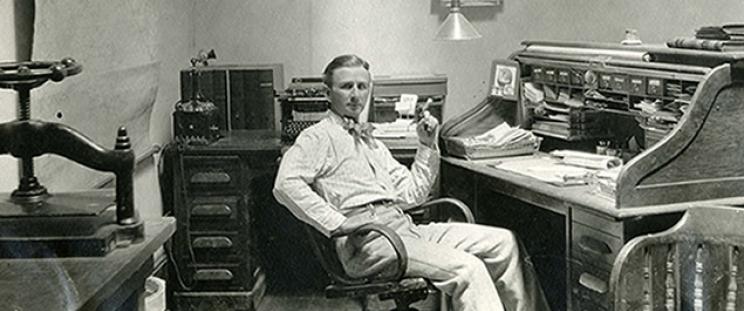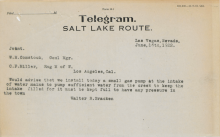Collection Paragraphs

On July 13, 1950, Walter R. Bracken, former Vice President of the Las Vegas Land & Water Company and longtime local agent and representative of the Union Pacific Railroad, died in his home in Las Vegas. A lengthy obituary befitting a longstanding civic leader, local businessman, and “Pioneer of Las Vegas," appeared the next day in the Las Vegas Review Journal. “Whose history in Las Vegas,” according to the RJ, “spanned half a century and established him as the pioneer with the longest continuous residence in the community.” The article recounted this history, born in Ohio, educated in Washington, Pennsylvania (at Washington & Jefferson College, presumably), and trained as a civil engineer.
In 1901 he joined Carl Stradley as locating engineer for the Oregon Short Line railroad, which was surveying a route from Salt Lake to Los Angeles. “Traveling with a team and buckboard, he entered Las Vegas for the first time and found the Old Ranch, with its plentiful water supply as a logical division point for the railroad. Recommendations made by his party resulted in the purchase of the ranch from the late pioneer Mrs. Helen M. Stewart.”
The Senator William A. Clark of Montana, President of the San Pedro, Los Angeles & Salt Lake Railroad company “which undertook the project for establishing the missing railroad link from Utah to California, acted on the recommendation and purchased the ranch. Then, Senator Clark appointed Bracken to be representative of the railroad in Las Vegas, even before the construction began.”

The account then tells how Bracken “aided with the surveys of the proposed townsite,” arranged for lots to be set aside for churches and public buildings, and was present at the auction of the lots on May 15, 1905, “which marked the official start of Las Vegas.”
Walter Bracken was undoubtedly one of Las Vegas’ most prominent citizens. He was the first postmaster, a charter member of the Rotary Club, a member of the Elks Club, and the Chamber of Commerce. He served on the School Board and was a longtime Mason, charter member of Vegas Masonic Lodge number 32 in which he was given the signal honor of elevation to the thirty-third degree, the only thirty-three degree Mason in Southern Nevada. But perhaps more important than any of these Masonic degrees or civic functions, he was the local official for the Union Pacific Railroad and its subsidiary the Las Vegas Land & Water Company, which owned the land on which the town was built, and which controlled its water supply. And as representative of the railroad he was the face of the region’s largest company and employer. He was a true pioneer in Las Vegas; he and his wife had lived on the old Stewart ranch before moving into one of the first houses built of Fremont Street. So his history was, in some respects, the history of Las Vegas. And by 1950, when many of the original pioneers had passed away, “the pioneers” had acquired a certain iconic aura.
Bracken’s role in the coming of the railroad and creation of the city was more modest than later accounts would credit. He was a junior surveyor on one of the many railroad survey teams that passed through the Las Vegas Valley, and stopped at the well-known and much visited Stewart ranch and hostelry. His earliest position in Las Vegas was as the store clerk for his older brother who managed the Stewart ranch and store for the railroad until the Las Vegas townsite was laid out and the lots auctioned. After his brother’s return to Utah, Walter took up the lease on the ranch intending to make a living ranching. But Bracken soon wearied of the unprofitable ranch and like many others moved into the new town where there were more business opportunities. A family connection with the Stewarts who built the railroad—Senator William A. and his brother J.Ross—no doubt contributed to his being appointed the local agent for the new railroad and for the new Land & Water Company, which was to manage the railroad property and water system in Las Vegas.
The Salt Lake Route, as it was known, had always been controlled by the Union Pacific, despite Senator Clark’s being a titular partner, and his brother J. Ross being a 2nd Vice President, but after 1921 it was entirely the Union Pacific, one part of the nation’s largest rail system, with its headquarters in Omaha, and offices in Los Angeles. The railroad would be the biggest business, landowner and employer in Las Vegas for many years, controlling not just its water system but also tracts of industrial, commercial, and residential developments which it leased, sold, serviced, and maintained. Walter Bracken, as the representative of the railroad and through his own personal business associations and interests, was inextricably bound and engaged in all the business, political, and civic issues facing the growing city of Las Vegas. His correspondence document almost all aspects of life in the city from water shortages, tourism, and civic promotion, to strikes and labor unrest. And he proved a loyal and stalwart advocate and protector of the railroad and its interests in Las Vegas, for which he incurred, on occasion, the enmity of his neighbors.
When the railroad decided to establish a town on the Stewart ranch property in Las Vegas, the decision was made to incorporate a separate subsidiary company to sell the town lots, manage the railroads’ properties (including the ranch), and to build and manage the town’s water system. When the rail line was complete and the town site platted, the Las Vegas Land & Water Company was duly incorporated and the railroad’s property conveyed to it.
Inquiry:
Compare the desires of Union Pacific personnel with those of Walter Bracken. How did Bracken advocate for a stronger Southern Nevada and how might Southern Nevada be different today had more of the Union Pacific’s plans been implemented?
The Las Vegas Land & Water Company, despite it being, at least on the railroad’s account books, a separate company, was completely controlled by the railroad, and Walter Bracken, as Vice President of the Water Company, reported to the various railroad departments and offices and ultimately to the President of the Union Pacific System in Omaha. All decisions, no matter how petty (whether Bracken could buy a car and what kind, or whether he could have modern toilet facilities built in his house) were reviewed by a complex hierarchy of officials in Las Vegas, Los Angeles, and Omaha. Most departments maintained local offices: for example there was a railroad attorney in Las Vegas who reported to the Legal Department in Los Angeles, and the local engineering office in Las Vegas likewise reported to the chief engineer in Los Angeles. The Los Angeles office also handled all accounts and receipts both from the railroad and the Las Vegas Land & Water Company.
Decisions requiring corporate authorization were made in Omaha, whose officers closely monitored not only local railroad operations, but state and local political issues as well. Legal matters from contracts, leases, law suits, labor relations, and freight charges, to applications and permits for the appropriation of water and the digging of wells—anything which was regulated by either state of federal agencies—went through the Law Department. All construction, surveys, maintenance of buildings, track, or water pipes went through the engineering department.
